Soaring Higher
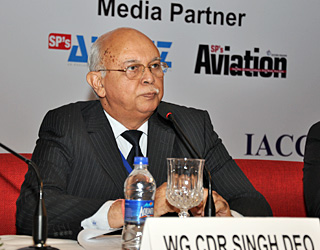
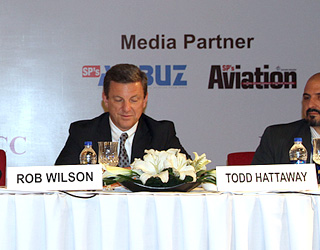
A day-long seminar, "Indian Civil Aviation Long Term Perspective", was held at Hotel Le Meridien in New Delhi, on September 19, 2011. Organized by the Indo-American Chamber of Commerce (IACC), with SP Guide Publications as media partner, the seminar brought together representatives from US and Indian civil aviation sectors and allied industries who exchanged notes on the challenges and opportunities before India’s civil aviation sector, which marks its centenary this year.
The seminar focused on the three key areas of airspace design, management, and modernization; airport development; operational airline economics; and general aviation. V. Somasundaram, member, Air Navigation Systems, Airports Authority of India (AAI), Alok Sinha, Joint Secretary, Ministry of Civil Aviation, Govt. of India, Kapil Kaul, Chief Executive Officer, Centre for Asia Pacific Aviation (CAPA), and Wg Cdr B.S. Singh Deo, Managing Director of Bell Helicopter India Inc. chaired the three sessions respectively.
Welcoming the delegates, Atul Sharma, Regional President of IACC said: "Seminars like this provide an excellent platform for identifying a roadmap for tapping the immense potential for growth in India’s civil aviation sector." He praised "the tenacity of air carriers who gamely fly on, in spite of losing money in their operations." It is mainly thanks to them that civil aviation could spread its wings in the country and soar to new heights. Private-public-partnerships are the need of the hour to help build badly needed infrastructure like greenfield and brownfield airports, noted Sharma.
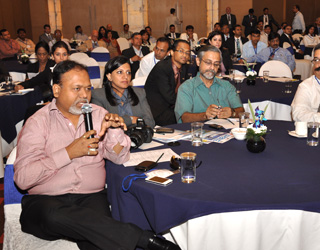
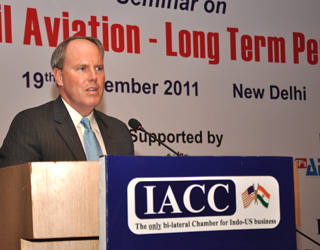
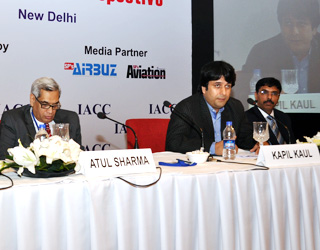
In his opening address, VP Agrawal, Chairman, AAI, gave a comprehensive overview of civil aviation in the country. The AAI provides air traffic services in Indian airspace and the oceanic airspace delegated to India by the International Civil Aviation Organisation (ICAO). "To cope with the recent unprecedented growth of traffic and meet the growing demand," he said, India is taking several measures to augment the Communications, Navigation & Surveillance (CNS)/ Air Traffic Management (ATM) infrastructure and various airspace capacity enhancement programmes. "These include simplified coordination and communication, achieving fewer operational positions through airspace redesign, and simplified ATM processes." Special efforts like the US-India Aviation Cooperation Program, he said, would give impetus to the overall growth of the industry in the country. The passenger growth in India’s civil aviation sector is cruising at over 20 per cent, which is among the highest in the world. At this rate, it will soon leave behind passenger growth of countries like China, France, and Australia and touch 400 million before this decade is out. In fact, an estimated 240 million travelers are expected to transit through the country in 2015. And considering that more than 70 percent of international travel is through airports, the development of world class airports is a key driver of growth. Reason enough, said Agrawal, "for India to make better use of its 115 airports, of which only 84 are currently active." But the statistics, though impressive, only tell part of the story. For regulation is a tricky realm. "We should try to have insurable liability situations nationally and internationally, so that issues like bird-hits and on-approach incidents could be better addressed. The effort should be to chart growth with a long-term perspective, even though initially we may have been caught napping by the sudden spurt in the growth of the sector." It is just as well that the 12th Five Year Plan has apportioned US $13 billion (Rs 65,000 crore) for the aviation sector. "With an active greenfield airport policy, we are on our way to becoming the 4th largest player in civil aviation after the US, China, and Japan." Helicopters, too, have a major role here, he said. "It’s important to build heliports at key locations to facilitate better connectivity, particularly in times of crisis such as, for instance, when helicopter-ambulances are urgently needed." Unlike in India, helicopters on ’medivac’ duty are a ubiquitous feature of the aviation scene in the US and elsewhere. We could take a leaf from their notebook.
For a strategic player in global aviation like India, air traffic management (ATM) is a critical requirement, and streamlining Air Traffic Flow Management (ATFM), he said, is important to make optimum use of airspace and airports. "Currently 35 percent of airspace in India is reserved for defence purposes; land-based facilities in this regard would be closer to 60 percent." The terrestrial navigational aids currently used in the country are Non-Directional Beacon (NDB), Distance Measuring Equipment (DME) and Instrument Landing System (ILS). Improvements in navigation include capabilities such as Area Navigation (RNAV) and Global Navigation Satellite Systems (GNSS) that provide world-wide navigation coverage and are already being used for global en route navigation and non-precision approaches. Once augmented or upgraded, these systems will support most precision approaches. When the Geo-Augmented Navigation System (GAGAN) being implemented jointly with the Indian Space Research Organisation (ISRO) -- becomes operational in June 2013, it will be possible to have Cat II and Cat III facilities at many airports. Such an all-weather, global navigation system would help in reaching a situation where airliners do not have to circle endlessly in the holding pattern, waiting for landing clearance from ATC. If there is any delay, it should be before take-off. This will ensure there’s no wastage of fuel and make airline operations more cost-effective.
Bob Smith Vice President & Chief Technology Officer (Engineering & Technology) of Honeywell echoed similar views and observed that OEMs, including Boeing and Airbus, are becoming major players in the regional aviation sector. "So it will become inevitable for ATM systems to be streamlined. Several technologies are coming off the drawing board and all of them essentially offer integrated solutions to help make ATM operations smoother and more efficient." The long-term forecast for India from 2015 to 2025, he said, indicates that growth in aviation could double in the next five years. "By 2030, however, this growth could treble, making India the third largest aviation hub in the world, after the US and China. This entails tremendous economic value and invests upon all of us the responsibility of ensuring that we secure the type of growth we want, and the type of future we want, for a global aerospace player." Honeywell could play a key role in helping this transformation. "Being listed as the largest systems provider in the world is only a part of this," he said, recalling Honeywell’s quarter-century-old collaboration with the Hindustan Aeronautics Limited (HAL). "Our effort is to transform the current cycle of this collaboration (with HAL) into a super-cycle of development."
Delegates stressed the importance of looking anew at cargo movement in a new light, given the fact high value cargo fuels economic growth. Seminar participants were treated to a perspective view of "Airports in Progress": a remarkable slide show of airports that are being upgraded. Once completed, their stunning designs and state-of the art passenger facilities would make airports like Chennai, Cochin, Thiruvanantapuram, Jaipur, Udaipur, Mangalore, Amristasr, Srinagar, Calicut, and Bhopal buzzing hubs of aviation activity, comparable to the best in the world.
Delegates concurred that a lot depends on the way the industry chooses to respond to constraints like emissions trading schemes and other structural factors that prevent the growth of the sector. "OEMs should consider this before entering the scene," as Bob Smith put it. "Honeywell wants to actively pursue a course that would help the Indian civil aviation sector overcome obstacles to growth". The idea is to do this without losing the focus on green aviation, recalling the fact that Honeywell was the first to make a trans-Atlantic flight exclusively on bio-jet fuel.
Robert A. Wilson, President, Business & General Aviation at Honeywell, observed that general aviation MROs have a crucial role to play in boosting the growth of the sector by offering integrated solutions "of the tip-to-tail" type. Noting that currently there are no major MROs within five hours’ flying time from India, he predicted that MROs for fixed wing aircraft, including turboprops, would register a growth of well over 10 percent by 2016. Modification of electronics and avionics is currently registering the fastest growth (9.4 percent) while components are not far behind at 8 percent. To meet this growth, MROs should reckon with the accompanying heightened expectations of customers who would want "24/7 support." "Regulatory challenges would include stocking up on spares and hub optimization."
Sorin-Dan Onitiu, Aero Engineering Manager, Government & Industry Affairs at Jeppesen (a subsidiary of Boeing Commercial Aviation Services), presented a birds’ eye view of the history of air traffic growth in the world in general, and in India in particular. "Switching from an analog era to a digital one has had its problems," he said. "But I must say the industry has responded well, and today we are in a position to achieve unprecedented growth in civil aviation."





